Disruptive innovation to create growth: A research perspective
Economic growth is one of the main targets of a nation to reach prosperity. It is well known that developed nations leverage knowledge-based economic created from advanced research and high-value products or services.
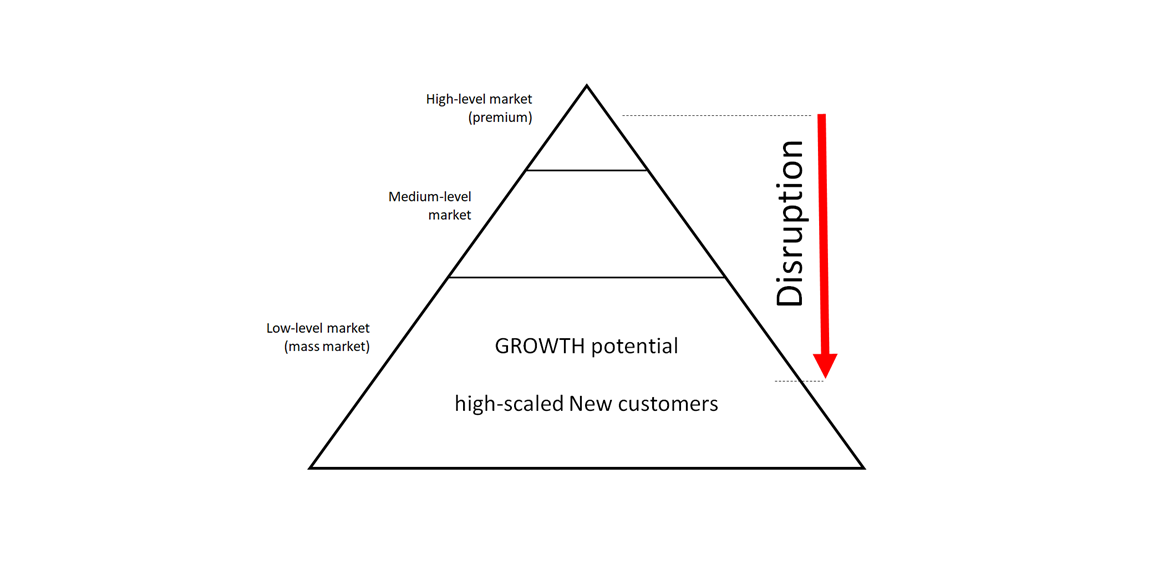
Economic growth is one of the main targets of a nation to reach prosperity. It is well known that developed nations leverage knowledge-based economics created from advanced research and high-value products or services.
The question is does research create growth in a nation’s economy? If yes, how can research create economic growth?
According to the theory of Prof Clayton Christensen [1], economic growth can be obtained from disruptive innovation in products and services.
Hence, what is disruptive innovation? What is the difference between disruptive and other types of innovation?
In this post, we will discuss what disruptive innovation is, why economic growth needs this disruptive innovation and what the relationship between research and disruptive innovation is and how research can contribute to disruptive innovation.
READ MORE: Research as value and economy creation activities
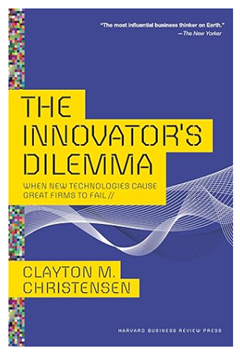
Types of innovation: Disruptive innovation, sustaining innovation and efficiency innovation
There are three types of innovations: disruptive, sustaining and efficiency innovations [1]. These three types of innovations have different characteristics and all of them are important, but not all of them will create growth!
Disruptive innovation is a type of innovation that brings expensive products/services to “low-level” markets. “Low-level” market product or service mean that the products or services are simple and easy to use, have affordable/cheap prices, target a high mass market but not too advanced users (demanding or professional users) and meet/satisfy minimum customer expectations.
Meeting the minimum customer expectations means that the disruptive products or services solve the main “jobs” or tasks that the customer needs to finish or solve.
Disruptive products or services usually have low-profit margins but can bring large profits from large customer purchases.
Sustaining innovation is a type of innovation that focuses on improving the quality and performance of existing products or services. Very common, this innovation is to make a leading product or service in its category to be far from other competitors.
The products or services obtained from sustaining innovations have characteristics of high-profit margin (in contrast to disruptive products or services) high technology, complex systems and processes, and targeting high-end users with expensive prices (premium products).
Leading companies usually invest in sustaining innovation (technology) and try to maximise profit margin from premium products or services.
Efficiency innovation is a type of innovation that focuses on the reduction of product/service costs so that the profit margin from a selling price can be improved without increasing the price. This innovation is usually in small size and consistent improvement in industries and is pursued after disruptive and/or sustaining innovations have been achieved.
Figure 1 below shows the common cycle of innovations: from "disruptive", "sustaining" and then "efficiency" innovations. From Figure 1, initially, a product comes from a low-level market as an affordable product or service and then the product improved to go upmarket targeting premium customers.
For example, initially, compact cars from Toyota were made to enter US markets and create new customers and market share. Then, continuously, Toyota improved their car quality, via sustaining innovation, and went up the market until they could compete with high-end car brands with their Lexus products. Then, Toyota keeps reducing their production cost by improving their efficiency through efficiency innovation.
From Figure 1, many companies will stuck in "efficiency" innovation phase and enjoy the high profit margin from their high-value product. However, they should keep the innovation circle back to disruptive innovation to maintain their growth and to not be disrupted by new competitors that can “eat” their low-level market customers.
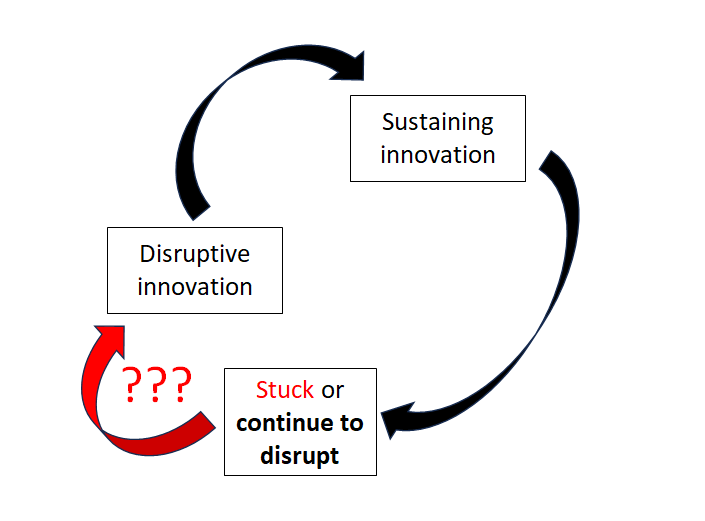
Meanwhile, table 1 shows the main characteristics of "disruptive", "sustaining" and "efficiency" innovations.
From Table 1, disruptive innovations will create not only new customers but also new “jobs” or functions. However, some capitals are required to be invested for this disruptive innovation.
For example, the introduction of mobile phones creates more “jobs” or functions for users, such as mobile banking functionalities that do not exist otherwise. Another example is Amazon retailer. Amazon disrupts conventional retailer systems and creates new “jobs” or functions such as new ways of becoming a retailer. Both the introduction of mobile phones and Amazon shops need capital investment to develop the system and technology.
Sustaining innovation usually only creates little new “jobs” or functions. But it also only uses little capital investment compared to disruptive products or services. For example, some mobile phones target premium customers and hence improve their technology level of the phones. However, there is no new function from this new technological advancement except a few.
Finally, efficiency innovation generally does not need a new capital investment. Its main focus is to reduce production and operation costs. However, since the product and service and their features are still the same, there are no new “jobs” or functions given by the product or service.

READ MORE: Research: Lessons learnt from “Hands of Time: A Watchmaker's History of Time”

The dilemma of sustaining innovation to pursue high-quality (premium) products
Sustaining innovation aims to improve existing products up to a premium product with high-quality, expensive and high-margin profit.
However, premium products generally will not target new customers. In fact, it is targeting existing customers. Because, when an existing customer buys the latest version of a high-quality or premium product, this customer will not buy another similar product, especially from the previous version of the product.
The caveat of a premium product or service is that they usually exceed customers’ ability to absorb or utilise the performance or function/ or features of the product/service (that is, over-qualified product or service).
It is the nature of a product development cycle that this process will always improve a product/service beyond the offering of competitors until the product or service exceeds customer’s expectations or ability to use all improved features.
An obvious example is for ordinary office workers. For these types of workers, they will underutilise the latest Intel core 7 or AMD Ryzen 7 processors capability. Most of their tasks will maybe only require 30% of the maximum capability of the processors. Similarly, an ordinary customer will not need a very high-end mobile phone since they only use the phone for calls and messages.
Figure 2 below shows the illustration of the customer limit of absorbing features, functionality or performance of a product/service and its relation to disruptive and sustaining innovation.
In Figure 2, most improved products, obtained from sustaining innovation, exceed what most customers really need. For example, workstations or even mainframe computers are over-qualified for most computer users albeit these computers have a very high computing performance and memory capacity.
Meanwhile, a mobile computing platform, such as a mobile phone, although in general has much less computing capabilities compared to workstations or mainframe computers, this computing platform will satisfy the need for computation for most customers or users. This mobile computing platform is the result of disruptive innovations.
Disruptive products or services mostly position themselves at the threshold of the customer's ability to utilise the product by having affordable prices and simplicity to use the products or services.
Of course, inside the class of mobile computing, there is also a separation between which platform is considered premium, such as the IPhone and Samsung Galaxy Ultra S series and which platform is considered low-cost, such as affordable mobile phones. Inside this category of mobile phones, there will be a similar illustration as what has been shown in Figure 2.
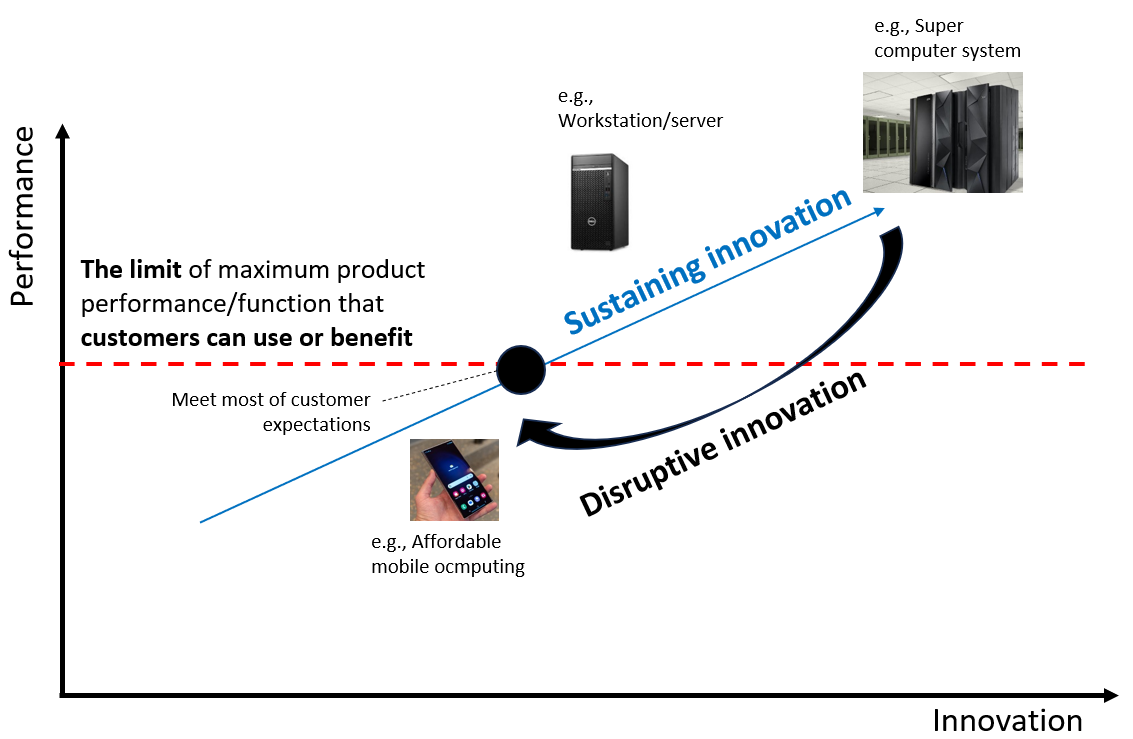
All of these innovations (disruptive, sustaining and efficiency) should be maintained to serve their own purposes.
A company or nation should perform all of these innovations to target both: high-end customers with sustaining innovation (to maintain technology leadership) and low-end customers with disruptive innovation as well as efficiency innovation to increase profit-margin.
However, growth (company/economy) will only be obtained from disruptive products or services.
READ MORE: Is research expensive?
Why disruptive innovation can create growth
Growth can only be created by disruptive products or services created from disruptive innovation. Disruptive products/services will target mass-market customers as well as new customers and, then, increase market shares.
Meanwhile, sustaining and efficiency innovations, although increasing profit margins via high-quality premium products/services and reducing operating and production costs respectively, these two innovations will not create growth.
Because the numbers of customers that consume premium products/services will likely be the same and they are usually loyal customers to the products/services.
Talking about growth, we must be careful with how we measure growth. It is very common in finance that everything is measured by financial ratios.
Because, by their definition, the numbers of these ratios can be manipulated to make them “look” high, but they do not represent the real condition of a company.
For example, one of the very common ratios is Return on Asset (ROA). ROA is the ration between net profit and asset. Hence, so to increase the metric, instead of improving profit, a company just can sell their assets to make their ROA metric high, but in reality, their profit may be the same or even lower and actually the company is not growing!
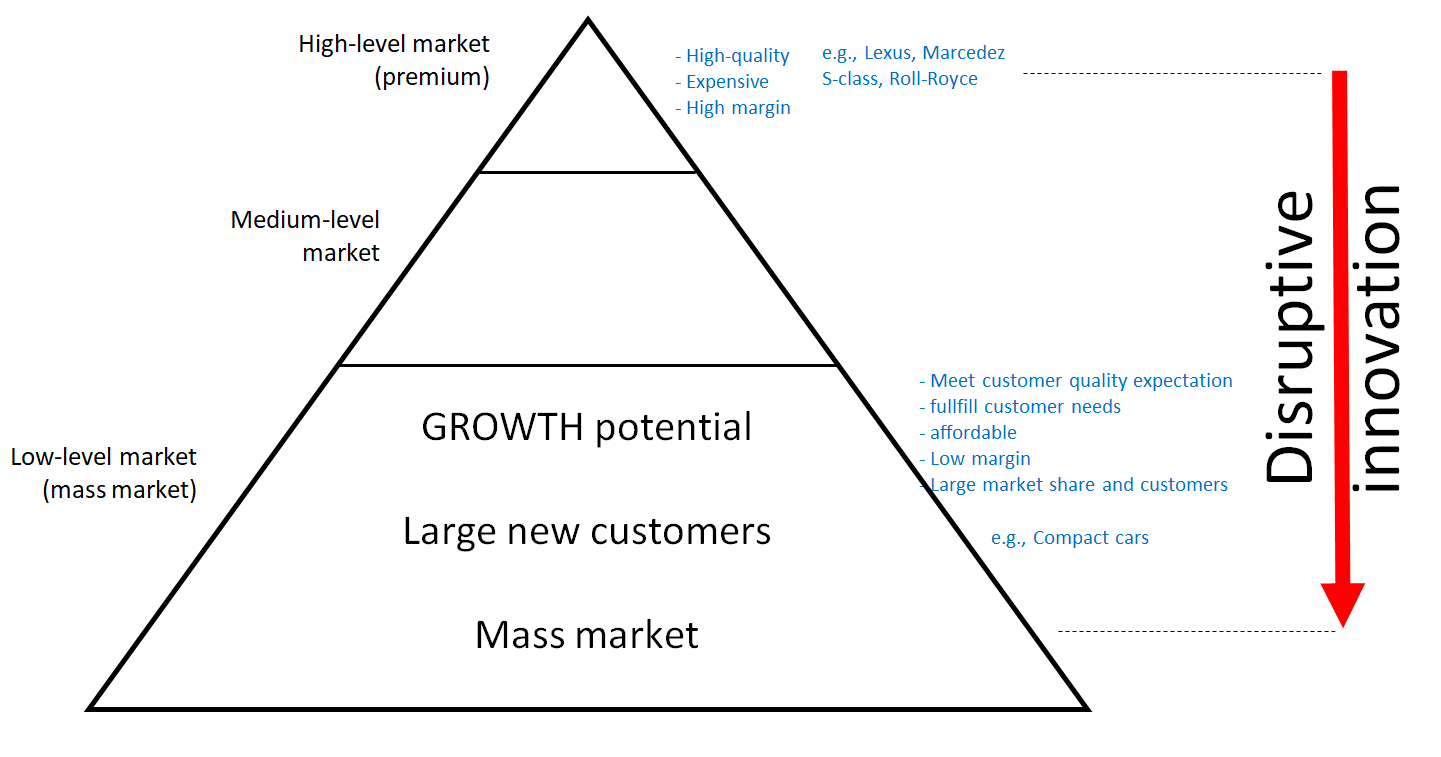
In Figure 3, we can see that a high-level market, although has a high profit margin, it only captures a small portion of the total market shares of potential customers who want to use a product. Meanwhile, low-level market, although the profit margin is usually not as big as the profit margin in the high-level market, this low-level market captures the biggest portion of potential customers.
Hence, although small profit margins, if a product can be absorbed by a large number of customers, the product will bring a significant amount of profit to the company that makes a product and can capture the market share.
Disruptive innovations will innovate to bring expensive premium products from a high-level market to a low-level market (accessible and affordable market) and capture new customers of mass markets, and then create growth!
A small company or new company can beat big existing companies with this disruptive strategy that leverages disruptive innovations. The disruption process always comes from eating the large low-level but mass market, and then going upmarket and taking over the competition.
If a small or new company starts directly to target the competition at the high-level market, this company will be “killed” or acquired by existing companies that are already in those high-end market segments.
The next question is how we can create disruptive products or services to take the mass customers at the low-level market.
To create disruptions, we need to classify products based on “job” as the unit of measure [1]. We need to focus on the “job” and not on the “customer”.
“job” is something that customers want to do or finish. That is, what the function of a product or service is so that they can help the customers do or finish their job.
When defining products by “job”, new disruptive ideas will occur and disrupted products/services can be produced by a company. By these disruptive products, the company can grow exponentially.
For example, Ikea sells products that can serve the “job” of easy moving and quick set up furniture for everybody at an affordable price. The McDonald’s milkshake is designed to serve the “Job“ of people filling time while driving on a boring long way high way in the morning. Cars, planes and trains are made to serve the “job” of people moving from points A and B.
The main characteristic of a “job” is that it is constant over time. Since “job” is constant, it means that the demand will always be there. So, focus on a product or service that can do a specific “job” efficiently and effectively to get new customers.
There are elements or sources of opportunity to create growth by capturing new customers and creating market applications [1]:
- Customers who are trying to find a simple and affordable solution to finish their task that only expensive and complex solutions are available.
- Customers who are trying to find new channels and/or new venues to use products that can only be obtained from existing channels or venues.
- Customers who are trying to find products or services that are currently unavailable to finish their specific jobs even though the products or services may not be as good as what the customers expect (better to have an underperformed product than nothing at all).
Maybe, the technology and knowledge to enable or push disruption are complex or sophisticated. However, these complex and sophisticated technologies and knowledge are used by a disruptor to make a product that is simple to use, affordable, gets the job done and is convenient at affordable prices.
A disruptor that can introduce a product with the same functionality to finish a “job” that is affordable and easier to use than its premium product competitors will likely succeed. Because, very common that existing competitors with premium products will overlook this situation and will not acquire or “kill” the disruptor’s product.
Because, the existing company, for some time, may not feel the effect on their market and total profit. The existing company usually focuses on improving their product to satisfy their current customers instead of focusing on finding new customers.
Some examples of disruptive innovation processes
Toyota entered the American car market with a cheap and not high-quality compact city car. The car quality is far below the quality of existing car manufacturers, such as, ford and general motor.
Although the quality is low, the car price is very cheap so many people, who are previously could not own a car, can buy this cheap Toyota car. From this cheap car, Toyota can collect a large profit from large customers who cannot buy cars from other manufacturers.
Then, from this capital, Toyota invested (to perform sustaining innovation) their capital to improve the car quality and have higher prices until Toyota could make a very high-quality Lexus car and compete in the high-level car market together with BMW, Mercedez and other high-end car brands.
In the meantime, while Toyota is busy competing in the high-level car market, KIA and Hyundai have started to disrupt Toyota's low-level American car market. KIA and Hyundai supply affordable compact city cars that previously were supplied by Toyota (when they first entered the US market). And then, the disruption cycle starts.
Another example is the disruption of inkjet printing by Hewlett-Packard to existing laser printing. This inkjet printing is much more affordable and compact in size compared to laser printing as well as easier to maintain compared to laser printing. From here, inkjet printing is now ruling the customer printing market in the world.
Disruptive innovation requires some elements of technology
One important thing to note is that disruption processes start from the low-level market (mass market where most customers lie), improve the quality of the products/services and go all the way up to the high-level market. However, this disruption processes of going upmarket require some elements of “Technology” in the business model of the products/services.
For example, McDonald's, one of the biggest cheap fast-food chains, cannot go upmarket level. That is, McDonald's cannot disrupt the high-level market, in this case, expensive/premium restaurants. Because the business model of McDonald's does not have enough “technological elements” to be improved. Hence, if they want to go upmarket, they need to copy the same business model of premium restaurants. Meaning, McDonald's will have the same expensive price as them!
There are examples of failed disruptive products or services. One example is as follows. In 1990, Oracle failed to disrupt home personal computers (PCs) to grow the market. They thought that a $200 PC that could access the internet and perform the basic functions of a PC would be absorbed by most home customers.
It turned out that their home PC could not give them the growth that they wanted! Because the home customers simply did not have tasks or jobs to be done by a home PC. No matter how cheap the PC was, the customer simply did not need them at that time.
As being discussed above the approach to define a product by “job”. Customers will buy a product or service only if they have a problem or job to be solved by the products or services.
A famous example of disruptive product generation due to “job” classification is when Sony was led by Morata. In Morata’s era, Sony designed products focusing on “job” to do at affordable prices and simple to use. In that era, Sony disrupted the market with portable transistor radio, Walkman, etc. In Steve jobs’s era, Apple disrupted the established Sony Walkman’s market with their iPod products.

Disruptive innovation: A research perspective
Now, let us make a relationship between research and innovation. Of course, every research is an innovation. However, each category of research serves their own purposes.
Generally, research is divided into levels, called technology readiness level (TRL). There is a total of nine TRL levels.
Research at TRL 1-3 is defined as basic research that tries to observe, model or invent new phenomenon or knowledge. This type of research pushes the boundaries of a field to the next level and opens new ways of development.
TRL 1-3 research can be viewed as sustaining innovation due to its main goal to create new knowledge and invent new things. The main funder for this research is usually the government of a country.
However, there are situations where this basic research at TRL 1-3 is needed to support disruptive innovation by inventing a way to make a product become affordable such as the invention of a new manufacturing system concept or to make a service become available, such as mathematical research in computer science that opens the door for products/services democratisation, such as what happens in the machine learning field.
Research at TRL 4-6 is mainly for creating prototyping or demonstration of concepts obtained from the output of research at TRL 1-3. Since this research is to bridge the gap between basic research outputs and industrial products or services, both government and industry should join forces to fund this type of research. Similar to TRL 1-3, this research is likely toward "sustaining" innovation.
Research at TRL 7-9 is mainly industrial research to introduce products or services into markets to be absorbed (purchased) by customers. Since this research is to create a market-ready product or service (preferably mass product/service), industries have the full responsibility to perform and fund this research.
This industrial research (TRL) can be viewed as having a focus on disruptive innovation. That is, to bring a ready-to-use product or service that is as affordable as possible price, is simple to use, and is targeted to mass customers.
It is expected that the output of this TRL 7- research will generate profits and bring capital to fund research at TRL 1-3 and TRL 4-6.
However, research at TRL 7-9 can also be a sustaining innovation process if the main goal is to make a premium product at a high price and high margin, to target high-end customers.
That is, research at TRL 1-6 is weighted toward sustaining innovation. Meanwhile, research at TRL 7-9 is weighted toward disruptive innovation. Although, that research can be designed for either disruptive or sustaining innovation.
All research at various TRL levels is important and should be maintained to serve its own purpose: to push technological know-how and to create market (economic) growth of a company or nation to fund the research activities!
The main takeaway is that, if research is to create growth, the research should be steered to create disruptive products or services whatever TRL level the research is.
READ MORE: Reverse step: building research and knowledge from data or observation study
Conclusion
Disruptive innovation is about creating an alternative product/service that is simple to use, affordable and meets, at least, basic customer quality expectations and otherwise cannot be found in premium products.
Since disruptive products or services target mass customers and also new customers, they can create growth in a company or nation.
Of course, other innovations, such as sustaining and efficiency innovations, are also important and needed. Sustaining innovation is needed to keep the competitive advantage of a company or nation and efficiency innovation is needed to increase profit margins (by keeping the selling price the same).
Also, for research, research should target these three innovations. However, to create growth, research should be directed towards the creation of disruptive products or services. Research at TRL 7-9 is probably the most suitable research to create these disruptive products or services.
Reference
[1] Christensen, C. and Raynor, M., 2013. The innovator's solution: Creating and sustaining successful growth. Harvard Business Review Press.
You may find some interesting items by shopping here.
